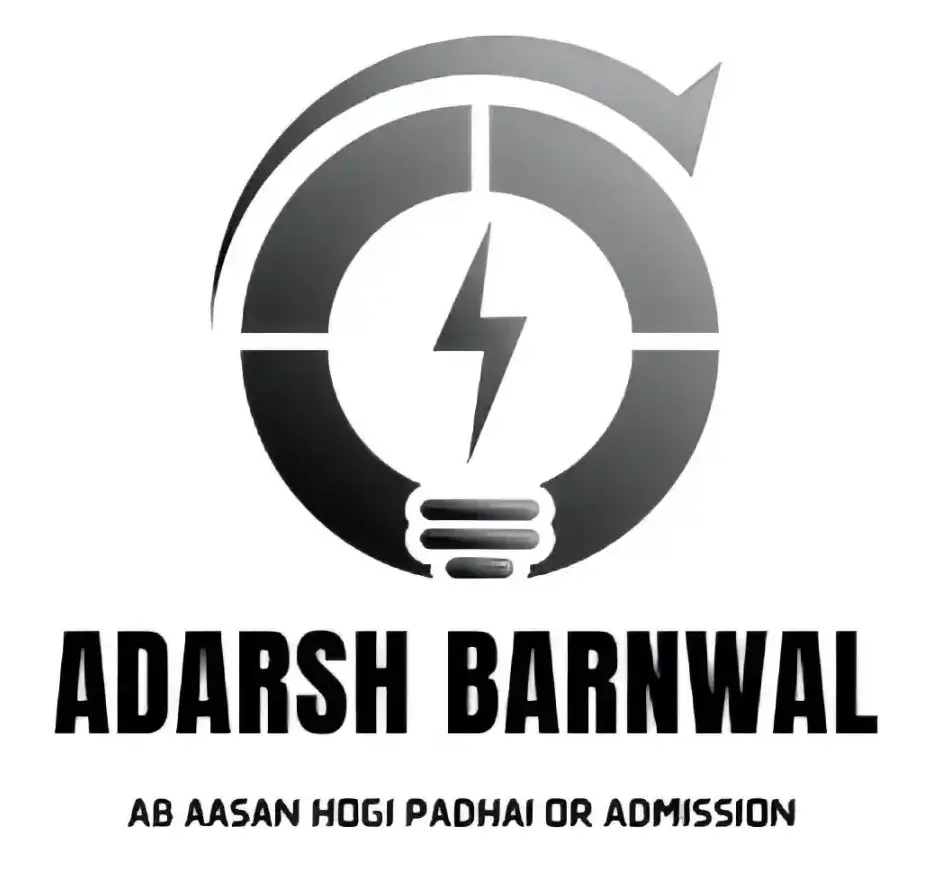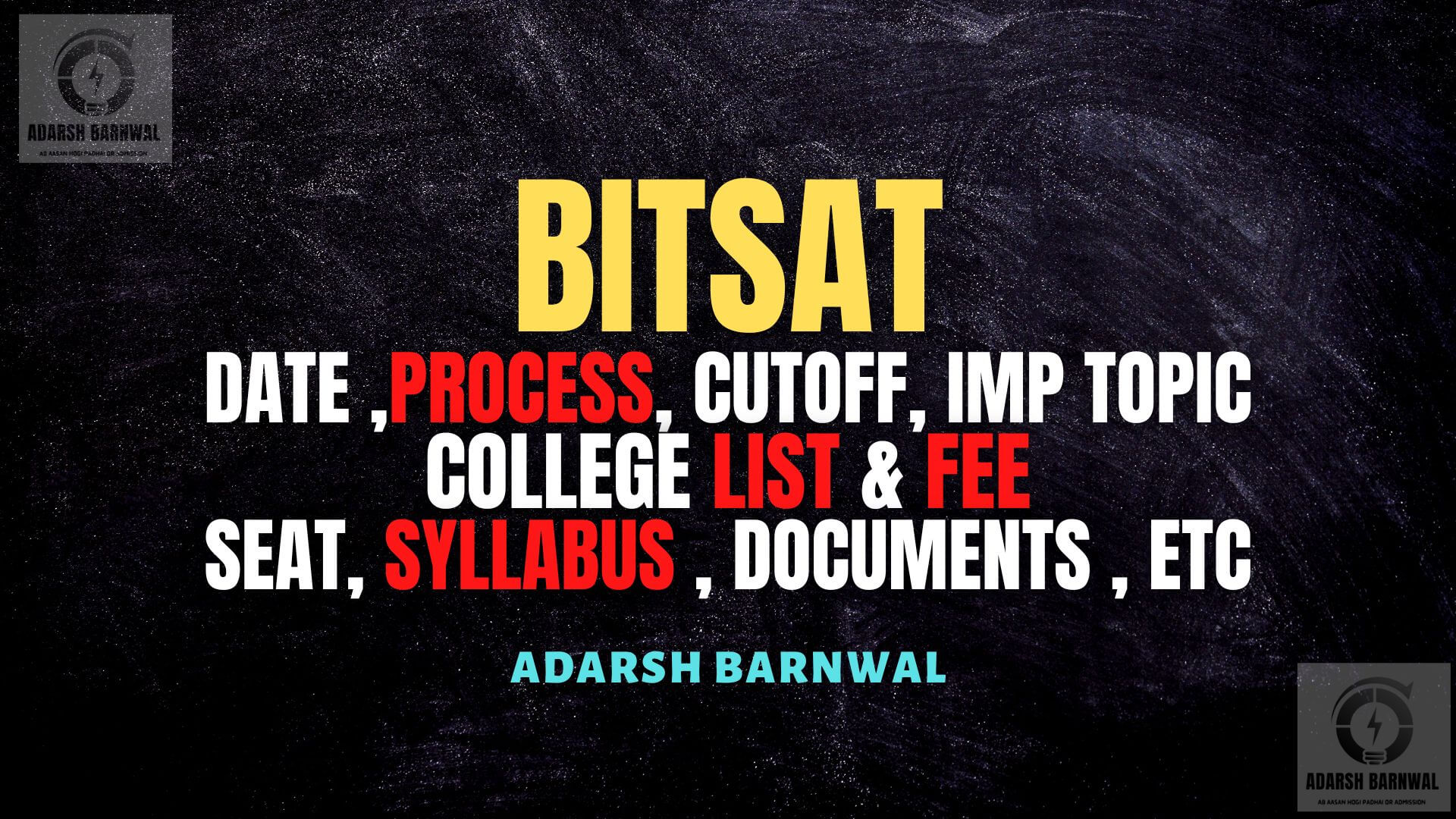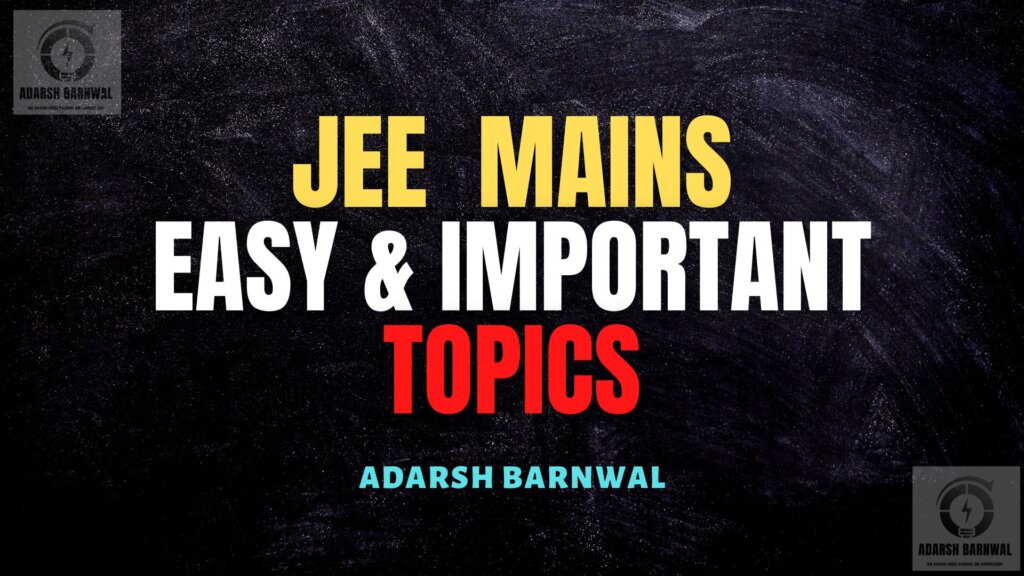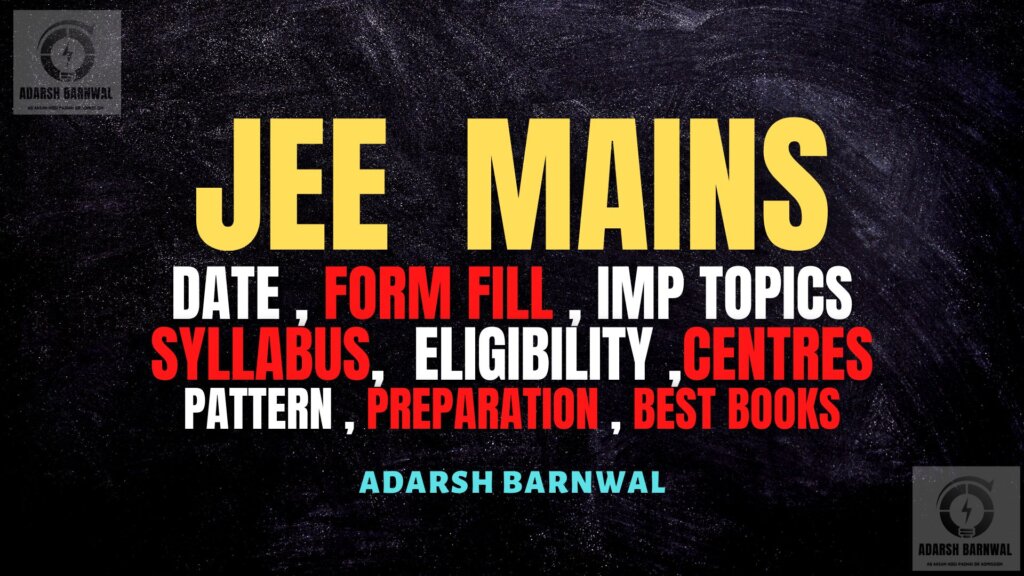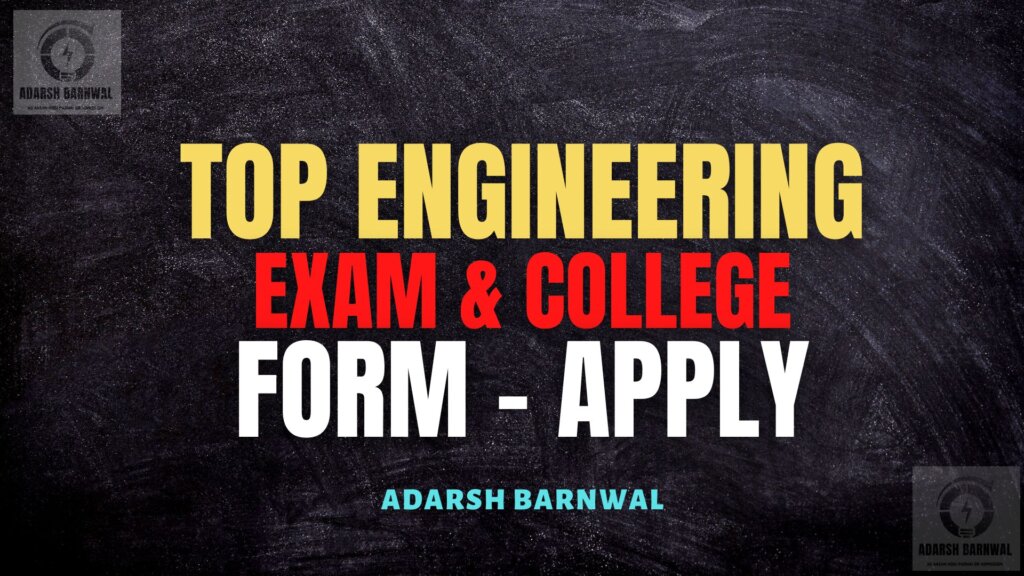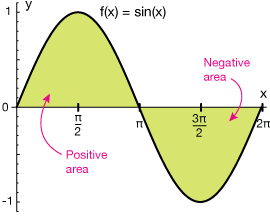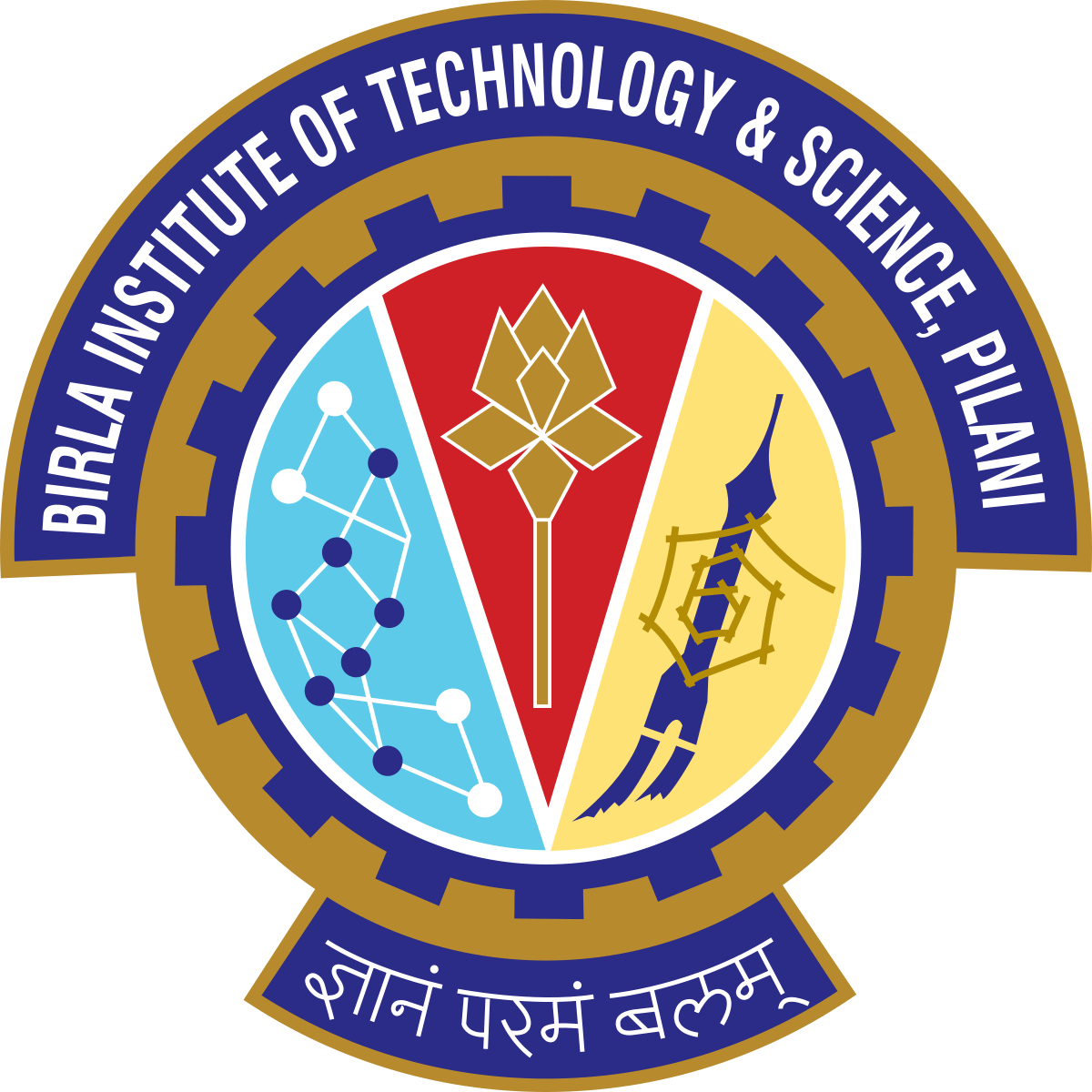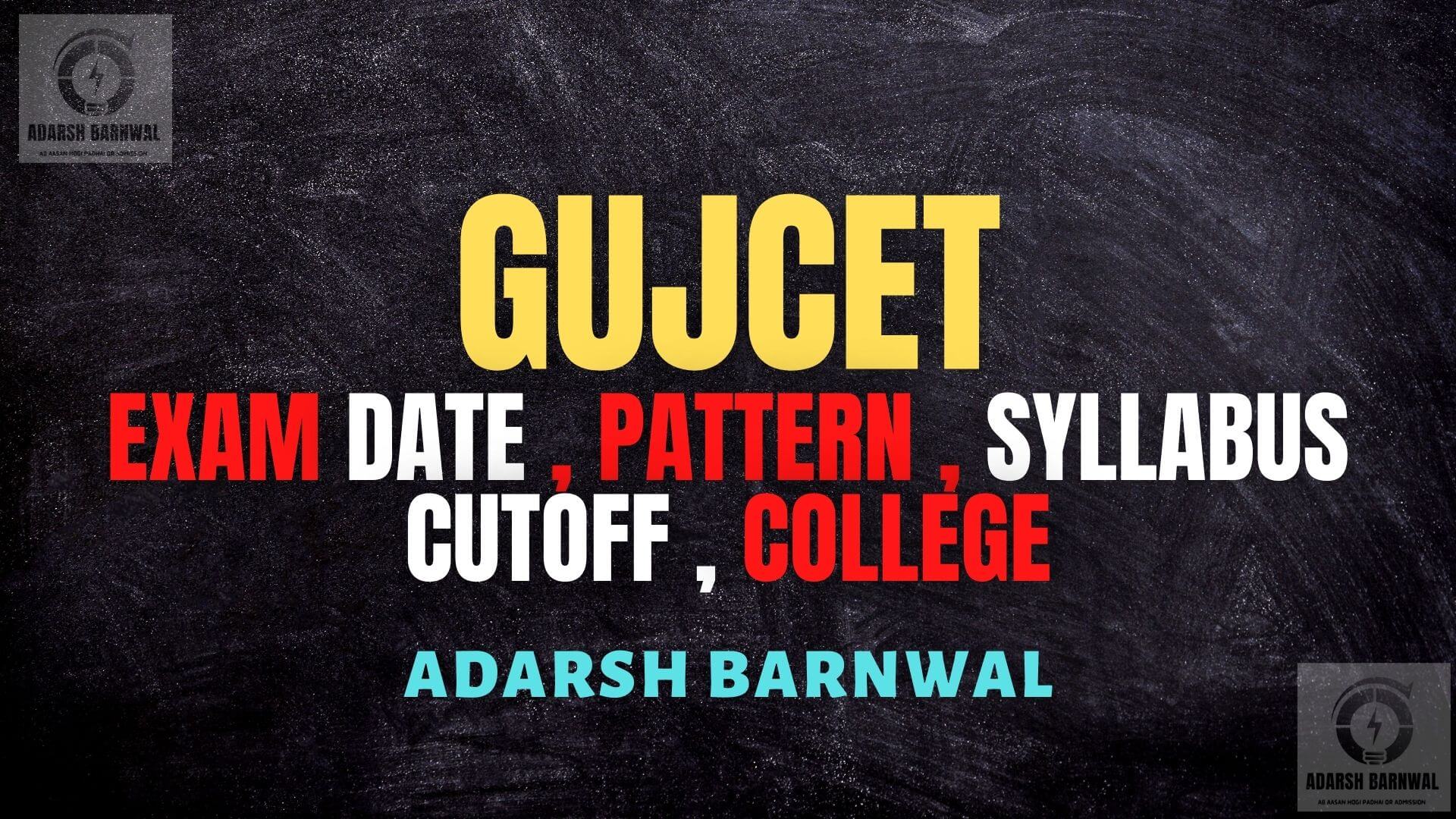BITSAT 2024: The Birla Institute of Technology and Science conducts BITSAT exam for shortlisting candidates for admissions into its Integrated first degree programs in science, engineering and pharmacy. The admission is provided to the candidates in one of the BITS campuses located in Pilani, Hyderabad, and Goa. Bits Pilani Review, Placement etc – click BITSAT is a university-level entrance test granting admission in B. Pharm and B.E & M.Sc courses.
BITSAT 2024 Application Form has been released. You will be able to register online through the official website, bitsadmission.com. The last date to apply is April 11, 2024. BITS Pilani has also released BITSAT exam dates for both sessions. Session 1 is scheduled to be conducted from May 19 to 24, 2024 and session 2 date is June 22 to 26, 2024.
For BITSAT 2024, candidates will get 3 hours to complete the exam. The exam will be conducted as a computer-based entrance test with four sections including- English Proficiency & Logical Reasoning, Physics, Chemistry and Mathematics or Biology. BITSAT Syllabus at par with the syllabus of JEE Main. Topics in BITSAT Syllabus are based on CBSE NCERT Class 11th and 12th.CLICK HERE to download a copy of the brochure (pdf format).

BITSAT 2024 Highlights
| Exam Name | BITSAT 2024 |
| Full Name | Birla Institute of Technology & Science Admission Test |
| Exam Level | National |
| Courses Offered | Integrated Engineering, Sciences, Technology and Pharmacy |
| Conducting Body | BITS, Pilani Bits Pilani Review, Placement etc – click |
| Application Mode | Online |
| Exam Mode | Online |
| Official website | http://bitsadmission.com/ CLICK HERE to download a copy of the brochure (pdf format). Bitsat Application Form apply |
| Helpline | 01596-242205, 01596-515330 |
| [email protected] |
BITSAT 2024 Exam Dates
BITS Pilani will release BITSAT 2024 Exam Dates along with the information brochure in the last week of January 2024. The exam is condcucted in two sessions – Session 1 (May Session) and Session 2 (June Session). Candidates can check the tentative dates for BITSAT 2024 below. Bitsat Application Form apply
| Activity | Date |
| Start of application form | January 15, 2024 |
| Deadline to apply online for BITSAT-2024 for Session-1 or Both the sessions | April 11, 2024 |
| Revision/editing (online) in the application form by candidates | April 15-19, 2024 |
| Test center allotment and announcement to candidates | May 1, 2024 |
| Candidates to reserve Test date and slot. $ | May 6-10, 2024 |
| Candidates to download Hall tickets with instructions (for Session-1) | May 15, 2024 to till the exam date |
| BITSAT-2024 Online Test Session-1* | May 19-24, 2024 |
| The application window to apply for BITSAT-2024 Session-2 only | May 22 to June 10, 2024 |
| Revision/editing (online) in the application form by candidates | June 11-12, 2024 |
| Test center allotment and announcement to candidates | June 13, 2024 |
| Candidates to reserve Test date and slot. $ | June 15-17, 2024 |
| Candidates to download the Hall tickets with instructions | June 19, 2024 to till the exam date |
| BITSAT-2024 Online Test Session-2* | June 22-26, 2024 |
| Apply for admission with 12th Marks and Preferences of Programmes | June 1-28, 2024 |
| Editing of Marks/Preferences in Application form | June 29-30, 2024 |
| Admit list and Waitlist announcement after Iteration I. | July 3, 2024 |
| Deadline for accepting the offer along with payment of fee/advance fees. | July 08, 2024 |
| Announcement of admission assignment after Iteration II. | July 11, 2024 |
| Deadline for payment of balance fees by candidates selected for admission from the waiting list in Iteration II. | July 15, 2024 |
| Deadline for candidates who wish to withdraw their admission to submit a withdrawal request online using required credentials. | July 13-16, 2024 |
| Announcement of admission assignment after Iteration III. | July 19, 2024 |
| Deadline for payment of balance fees by candidates selected for admission from the waiting list in Iteration III. | July 22, 2024 |
| Deadline for candidates who wish to withdraw their admission to submit a withdrawal request online using required credentials. | July 24-25, 2024 |
| Reporting of candidates selected for admission in Iterations I, II, and III at their respective campuses (other than the BITS-RMIT Academy students) and their Document verification and completion of other Admission formalities. | July 30, 2024 (9:00 AM) |
| Fresh-students Orientation Programme who have reported and completed their Admission formalities on July 30, 2024, at respective Campuses. Detailed information will be provided by the respective Campus. | July 31, 2024 |
| Fresh-students Orientation at the respective Campuses | July 31, 2024 |
| First Semester begins | August 01, 2024 |
| Registration for all students at the respective Campuses | August 01, 2024 |
| Class-work begins at the respective Campuses | August 02, 2024 |
| Announcement of admission assignment after Iteration IV to VI and subsequent deadlines for payment of balance fees by candidates and their reporting at the respective Campuses. | August 02-21, 2024 |
Bitsat Important Topics & Weightage – PDF
Note – the weightage can vary year to year – Don’t rely only on important topics , i would suggest you to read all topics , yes you can give extra attention to these topics

BITSAT 2024 Eligibility Criteria
The detailed BITSAT eligibility criteria for various courses are written below. The candidates must meet the minimum eligibility criteria before applying for BITSAT 2024 exam:
For all programmes (except B.Pharm):
- The candidates who have passed class 12th or equivalent exam from a recognized board with Physics, Chemistry, and Mathematics as mandatory subjects can apply. Also, candidates should have proficiency in English.
- The candidates must have obtain minimum of 75% marks in the aggregate of Physics, Chemistry and Mathematics subjects and at least 60% score in each of these subjects individually.
- 12th class appearing candidates can also apply. Bitsat Application Form apply
For B.Pharm:
- The applicants should have passed their 12th or equivalent examination from a recognized board with Physics, Chemistry, and Biology and should also be adequately proficient in English.
- Candidates with PCM can apply for Pharmacy courses.
- A minimum total of 75% marks in Physics, Chemistry and Mathematics/ Biology subjects is needed while 60% marks in each of these subjects individually is mandatory to score.
- Appearing candidates can also apply for BITSAT 2024.
Additional Eligibility Criteria to Keep in Mind:
- Only students who are appearing for the 12th standard examination in 2024 or have passed in 2021 are eligible to appear in the BITSAT 2024. Students who have passed their Class 12 examination in 2020 or earlier are NOT eligible to appear in BITSAT 2024.
- If a candidate has taken more than one attempt in the 12th standard or its equivalent, only his/her latest performance will be considered, provided this attempt had been for the full component of subjects/courses prescribed.
- Candidates who are presently studying in any of the BITS campuses will not be eligible to appear for BITSAT 2024.
- Admissions will be made purely on a merit basis. The merit position of the candidate for admission will be based on the score obtained by the candidate in the BITSAT 2024. However, their eligibility for admission is subject to fulfilling the requirement of minimum marks in the Class 12 board exam, as mentioned above. Bitsat Application Form apply
BITSAT 2024 Application Form
The interested candidates can register themselves for BITSAT exam by submitting their application form online at bitsadmission.com. BITSAT 2024 application form will be published at the official website of BITS and must be submitted within time. Apply for Bitsat Exam – Click / Bitsat Application Form apply
How to Apply for BITSAT 2024?
- Refer to the official website of BITSAT.
- Bits Pilani Review, Placement etc – click
- Then register before starting filling out the application form.
- The candidates should submit a photo and signature in the desired format and pay the application fee.
- Make sure to upload the scanned images of the signature and photograph in JPG/JPEG format.
- The appropriate size considered for photographs must be between 1 KB to 30 KB.
- Submit all the required details and candidates can submit three different preferences for the exam center.
- Submit the application form and take a hard copy of the same for further use.
- Candidates interested in applying have to complete all the application processes like exam registration, exam selection, uploading documents, application verification, and fee payment.
- At the time of the registration process, candidates are supposed to provide their email ID & contact details in the application form. Make sure to submit all the details correctly else it will result in a correction.
- Candidates can pay the application fee in any way including offline/ online mode using credit cards, debit cards, and net banking.
- Candidates will get all the important information related to the application form on their registered ID & phone number.
- Lastly, candidates must not forget to take the hard copy of the duly filled application form as it will be required in the future as well.
BITSAT 2024 Application Fee
| Fee Payment Details(INR) | Indian & Nepal Centers | Dubai Center | ||
|---|---|---|---|---|
| Male | Female | Male | Female | |
| Only 1st Session | 3400/- | 2900/- | 7000/- | 7000/- |
| Both 1st & 2nd Session | 5400/- | 4400/- | 9000/- | 9000/- |
| Only 2nd Session | 3400/- | 2900/- | 7000/- | 7000/- |
| Students who applied for Session-I and later opt for Session-II | 2000/- | 1500/- | 2000/- | 2000/- |
Students who applied for session 1 but later opt for session 2 have to pay INR 2000 (INR 1500 for Female Candidates choosing exam centers in India or Nepal)
Bitsat Important Topics & Weightage – PDF
Note – the weightage can vary year to year – Don’t rely only on important topics , i would suggest you to read all topics , yes you can give extra attention to these topics
BITSAT 2024 Exam Pattern
BITSAT 2024 will be conducted in an online mode (Computer-Based) and candidates will get 3 hours to complete the examination.
- All the questions will be Multiple Choice Questions and the mode of exam will be English.
- A total of 130 questions will be asked in the exam .
- There will be a total of 4 parts in the question paper.
- The examination will include subjects– Physics, Chemistry, Mathematics/Biology, English proficiency and logical reasoning.
- Candidates who answer all the 130 questions in less than 3 hours will be given the option of attempting 12 extra questions in the remaining time.
| Part | Section | Number of Questions | Total Marks |
|---|---|---|---|
| I | Physics | 30 | 90 |
| II | Chemistry | 30 | 90 |
| III | English Proficiency | 10 | 30 |
| Logical Reasoning | 20 | 60 | |
| IV | Mathematics/ Biology | 40 | 120 |
| Total | 130 | 390 | |
BITSAT has 130 questions for all candidates. However, if a candidate attempts all the 130 questions and time still remains, an option to attempt 12 extra questions is available. Distribution of the extra 12 questions is provided below:
| Section | Number of Extra Questions |
|---|---|
| Chemistry | 3 |
| Physics | 3 |
| Mathematics/ Biology | 3 |
| Logical Reasoning | 3 |

BITSAT 2024 Syllabus & Important chapters
BITSAT 2024 syllabus will be based on the concepts studied by candidates in class 11th and 12th. The detailed syllabus for the exam is mentioned below:
Bitsat Important Topics & Weightage – PDF
Note – the weightage can vary year to year – Don’t rely only on important topics , i would suggest you to read all topics , yes you can give extra attention to these topics.
- Physics: Units & Measurement, Kinematics, Newton’s Laws of Motion, Impulse and Momentum, Rotational Motion, Work and Energy, Gravitation, Mechanics of Solids and Fluids, Waves, Heat and Thermodynamics, Oscillations, Electrostatics, Current Electricity, Magnetic Effect of Current, Electromagnetic Induction, etc.
- Chemistry: States of Matter, Chemical Bonding & Molecular Structure, atomic structure, Physical and Chemical Equilibrium, Hydrogen and s-block elements, p- d- and f-block elements, Principles of Organic Chemistry and Hydrocarbons, etc.
- Mathematics: Algebra, Trigonometry, Two-dimensional Coordinate Geometry, Three-dimensional Coordinate Geometry, Differential calculus, Ordinary Differential Equations, Probability, Linear Programming, Mathematical modeling, etc.
- Biology: Diversity in Living World, Cell: The Unit of Life; Structure and Function, Genetics and Evolution, Structure and Function – Plants, Structure, and Function – Animals, Reproduction, Growth and Movement in Plants, Reproduction and Development in Humans, Ecology and Environment, Biology and Human Welfare, & Biotechnology and its Applications.
- English Proficiency: Grammar, Vocabulary, Analogy, Reading Comprehension, and Composition.
- Logical Reasoning: Verbal Reasoning: Classification, Analogy, Logical Deduction – Reading Passage, Chart Logic ETC. Nonverbal reasoning – Pattern Perception, Figure Matrix, Paper Cutting, Rule Detection, etc.

BITSAT 2024 Preparation Tips
BITSAT exam is considered as one of the toughest and most competitive exams. Additionally, Class 12th scores are also considered while making the final admission offer. Thus students must perform well in the exam for admission to their preferred course.Some of the preparation tips which help candidates perform well in their BITSAT 2024 exam include:
- Make a timetable and start adhering to the same.
- Gather relevant study material for different subjects which help improve the candidates’ speed and accuracy in the exam.
- Make short notes of all the important topics while studying so that they can help while doing revision.
- Do more mock tests and practice papers as they help focus on strong and weak points. Also it helps make candidates know the style and pattern of questions asked. Download BITSAT Sample Papers
- Bits Pilani Review, Placement etc – click
Best books for BITSAT Exam 2024
The most recommended books which all candidates preparing for BITSAT exam must refer to include:
| Best Physics Books for BITSAT | |
| Concepts of Physics by H.C. Verma Vol 1 and Vol 2 | |
| Arihant Physics | by D. C. Pandey |
| Problems in General Physics | by I.E. Irodov |
| Best Chemistry Books for BITSAT | |
| Atkins’ Physical Chemistry | |
| Inorganic Chemistry | by J.D.Lee |
| Physical Chemistry | by N Awasthi |
| Best Mathematics Books for BITSAT | |
| Class XI & XII | R.D. Sharma |
| Differential Calculus | Arihant |
| Best Books for English Proficiency and Logical Reasoning | |
| BITSAT English Proficiency & Logical Reasoning | by Disha Experts |
| The Pearson Complete Guide to BITSAT (English) | by One Learn Education |

BISAT 2024 Slot Booking
Once the final list of test centers is published by the authority, the candidates are supposed to book the date and slot for BITSAT 2024 as per their comfort. Post confirming the slots, the candidate has to appear for the exam on the date and time chosen by him/her.
How to Apply for BITSAT 2024 Slot Booking?
- Refer to the official website.
- On the Home page click on the Slot Booking button.
- Then a login page will open where candidates are supposed to mention their user Id & Password.
- Now tap on the “login” button
- Now candidates can select the date and slot when they wish to sit for BITSAT 2024 and submit the form.
- Post the successful submission of BITSAT Slot Booking 2024, the candidates must download their BITSAT 2024 admit card.
BITSAT 2024 Admit Card
BITSAT 2024 admit card of the candidates who have successfully booked their test slot will be made available on the official website. The candidates must take a hard copy of the same while going for the exam. All the details related to the candidates and the exam center are published on BITSAT admit card 2024. The candidates not carrying the admit card will not be allowed to appear for the test.
How to Download BITSAT 2024 Admit Card?
- Refer to the official website of BITSAT.
- On the home page, click on the link showing the Admit Card.
- Post clicking on the same, a login page will open where candidates are supposed to enter their user Id and the password.
- Tap on the ‘login’ icon.
- Cross check all the information present in it carefully.
- Download the same and take a hard copy of the same.
BITSAT 2024 Result
BITSAT 2024 results will be displayed on the computer screen right after the completion of the test. BITS Pilani does not release BITSAT Result separately. The result will be displayed in terms of total correct and incorrect answers, along with the score. The candidates can also check their BITSAT score report on the BITS admission website on the next day of the test. The candidate can take a printout of their BITSAT score report for further use.Bits Pilani Review, Placement etc – click
BITSAT 2024 Admission Process
Post qualifying BITSAT 2024, the candidates are supposed to apply for the admissions by providing the details of their 12th marks and preferences to different degree courses offered at three campuses of BITS. Based on the details provided in the application form for admission, fulfillment of eligibility and marks scored in the entrance test, the shortlisted candidates will get a seat in their preferred course.
BITSAT Merit List 2024
The admission to the courses offered under BITSAT 2024 will be as per the performance of a candidate in the written test. It is compulsory for the candidates to secure the least cut off marks to get their name listed in the merit list. Only those candidates will be invited for admission who got their names on the merit list. The exam conducting authority will publish two separate merit lists for the B.Pharm program and other programs respectively. In case, the scores obtained by two or more candidates are the same then the exam conducting authority will apply a tie-breaker rule to conclude.
BITSAT Cutoff 2024
BITS Pilani will release BITSAT 2024 Cut off after the conclusion of BITSAT Counselling process. The final BITSAT score cut-offs to various degree programmes in the Academic Year (AY) 2023-2024 admission session are as below.Please note that the BITSAT maximum marks in AY 2023-2024 was 390, where as the maximum marks until 2021 was 450.
Bits Pilani Review, Placement etc – click
BITSAT 2023 Cutoff
| Program | BITS Pilani | BITS Goa | BITS Hyderabad |
|---|---|---|---|
| B.E. Computer Science | 331 | 295 | 284 |
| B.E. Chemical | 224 | 209 | 207 |
| B.E. Electrical & Electronics | 272 | 252 | 251 |
| B.E. Mechanical | 244 | 223 | 218 |
| B.E. Electronics & Instrumentation | 266 | 244 | 244 |
| B.E. Electronics & Communication | 296 | 267 | 265 |
| B.E. Civil | 213 | – | 204 |
| B.E. Manufacturing | 220 | – | – |
| B. Pharm | 153 | – | 135 |
| M.Sc. Biological Sciences | 212 | 204 | 204 |
| M.Sc. Chemistry | 213 | 205 | 205 |
| M.Sc. Economics | 257 | 239 | 236 |
| M.Sc. Mathematics | 236 | 221 | 219 |
| M.Sc. Physics | 235 | 222 | 219 |
BITSAT 2022 Cutoff
| Program | Cutoff for BITS Pilani | Cutoff for BITS Goa | Cutoff for BITS Hyderabad |
|---|---|---|---|
| B.E. Chemical | 191 | 165 | 162 |
| B.E. Civil | 167 | — | 158 |
| B.E. Electrical & Electronics | 258 | 237 | 230 |
| B.E. Mechanical | 223 | 191 | 182 |
| B.E. Computer Science | 320 | 286 | 279 |
| B.E. Electronics & Instrumentation | 249 | 224 | 222 |
| B.E. Electronics & Communication | 279 | 256 | 252 |
| B.E. Manufacturing | 184 | — | — |
| B. Pharm | 125 | — | 109 |
| M.Sc. Biological Sciences | 171 | 164 | 158 |
| M.Sc. Chemistry | 168 | 163 | 160 |
| M.Sc. Economics | 247 | 230 | 220 |
| M.Sc. Mathematics | 214 | 187 | 177 |
| M.Sc. Physics | 214 | 188 | 173 |

BITSAT 2024 Marks vs Rank
BITSAT Marks vs Rank analysis gives you an idea of what marks in BITSAT can get you what rank in the merit list. Given below is an analysis of BITSAT marks vs rank based on previous year statistics (2023):
| BITSAT Marks | Rank |
|---|---|
| >= 351 | 1-216 |
| 329-350 | 217-819 |
| 307-328 | 820-2305 |
| 285-306 | 2306-4885 |
| 241-284 | 4886-17217 |
| 197-240 | 17218-46,444 |
| Less than 190 | 45000 and above |
BISAT 2024 Exam Centers
BITSAT 2024 Exam Center list will be out along with the information brochure at the official website, bitsatadmission.com. Candidates can the list of BITSAT exam centers that the candidates can choose to appear for the test-
| Agra | Hyderabad Campus of BITS | Pune |
| Ahmadabad | Hyderabad City | Raipur |
| Allahabad | Indore | Rajahmundry |
| Bangalore | Jaipur | Ranchi |
| Bhopal | Jalandhar | Roorkee |
| Bhubaneswar | Jammu | Siliguri |
| Chandigarh | Jamshedpur | Surat |
| Chennai | Jodhpur | Tirupati |
| Coimbatore | Kanpur | Thiruvananthapuram |
| Delhi | Kolkata | Vadodara |
| Dubai Campus of BITS | Lucknow | Vijayawada |
| Ghaziabad | Mumbai | Visakhapatnam |
| Goa Campus of BITS | Nagpur | Agartala |
| Gorakhpur | Nasik | Mangalore |
| Gurgaon | Noida | Udaipur |
| Guwahati | Patna | Kohima |
| Gwalior | Pilani campus of BITS | – |
